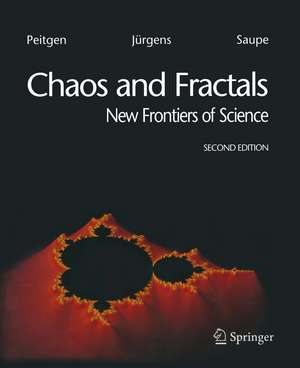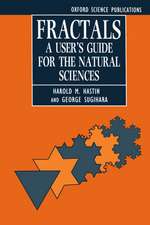Chaos and Fractals: New Frontiers of Science
Autor Heinz-Otto Peitgen, Hartmut Jürgens, Dietmar Saupeen Limba Engleză Paperback – 27 mai 2012
The fourteen chapters of this book cover the central ideas and concepts of chaos and fractals as well as many related topics including: the Mandelbrot set, Julia sets, cellular automata, L-systems, percolation and strange attractors. This new edition has been thoroughly revised throughout. The appendices of the original edition were taken out since more recent publications cover this material in more depth. Instead of the focussed computer programs in BASIC, the authors provide 10 interactive JAVA-applets for this second edition.
| Toate formatele și edițiile | Preț | Express |
|---|---|---|
| Paperback (1) | 510.80 lei 43-57 zile | |
| Springer – 27 mai 2012 | 510.80 lei 43-57 zile | |
| Hardback (1) | 637.94 lei 38-44 zile | |
| Springer – 3 feb 2004 | 637.94 lei 38-44 zile |
Preț: 510.80 lei
Preț vechi: 600.95 lei
-15% Nou
97.77€ • 106.24$ • 82.18£
Carte tipărită la comandă
Livrare economică 21 aprilie-05 mai
Specificații
ISBN-10: 1468493965
Pagini: 864
Ilustrații: XIII, 864 p.
Dimensiuni: 191 x 235 x 50 mm
Greutate: 1.52 kg
Ediția:2nd ed. 2004. Softcover reprint of the original 2nd ed. 2004
Editura: Springer
Colecția Springer
Locul publicării:New York, NY, United States
Public țintă
Lower undergraduateCuprins
Causality Principle, Deterministic Laws and Chaos.- The Backbone of Fractals: Feedback and the Iterator.- Classical Fractals and Self-Similarity.- Lim and Self-Similarity.- Length, Area and Dimension: Measuring Complexity and Scaling Properties.- Encoding Images by Simple Transformations.- The Chaos Game: How Randomness Creates Deterministic Shapes.- Recursive Structures: Growing Fractals and Plants.- Pascal’s Triangle: Cellular Automata and Attractors.- Irregular Shapes: Randomness in Fractal Constructions.- Deterministic Chaos: Sensitivity, Mixing, and Periodic Points.- Order and Chaos: Period-Doubling and Its Chaotic Mirror.- Strange Attractors: The Locus of Chaos.- Julia Sets: Fractal Basin Boundaries.- The Mandelbrot Set: Ordering the Julia Sets.
Recenzii
"It is one of thebest introductions to chaos and fractals around. … Unlike some other books onfractals, it can be read by non-specialists … . The book is beautifullyproduced and well illustrated so it is a pleasure to read." (HughWilliams, The Mathematical Gazette, Vol. 90 (5l9), 2006)
"The first edition of thisvast introduction to chaos and fractals appeared in 1992. This new edition isvirtually identical to the original except for some material … . the book is …a wonderful tour of a fascinating area of mathematics, and now the reader cantake this tour while carrying around a slimmer (but still hefty) volume. … Theauthors have a friendly conversational style … . This is a great book … ."(Raymond N. Greenwell, MathDL, May, 2005)
"Chaos andFractals: New Frontiers of Science is an amazing introduction to the ideas offractal geometry and chaotic dynamics … . The authors have done a tremendousjob in explaining quite difficult concepts in an elegant and simple way … . Ienjoyed this book tremendously – the authors have put in a tremendous amount ofwork in making a vast and interesting subject accessible … . I wholeheartedlyrecommend this book to anyone with even a passing interest in the subjectmatter." (Dr. S. Virmani, Contemporary Physics, Vol. 46 (6), 2005)
"There appearedmany books in the 1980’s and early 1990’s that … required only a limitedmathematical background to understand. They made the fractals, chaos and theMandelbrot and Julia sets quite popular … . The … book that is under reviewhere is one of these popular books. … The book will remain what it has been sofar: an outstanding book that contains all you ever wanted to know aboutfractals and chaos accessible to all levels of mathematically skilled."(Bulletin of the Belgian Mathematical Society, Vol. 12 (3), 2005)
"The book iswritten for everyone who wants to learn details of chaos theory and fractalgeometry, also for readers who have not much knowledge of technicalmathematics. In the fourteen chapters the central ideas and concepts of chaosand fractals are developed … ." (F. Haslinger, Monatshefte für Mathematik,Vol. 144 (4), 2005)
"This is the second… edition of what has been a bestseller since its first publication in 1992. …All the laudatory comments heard twelve years ago about this fascinating bookremain entirely valid. No one has succeeded in better presenting … . thepresentation has not aged at all – the comprehensiveness of the underlyingmathematics and the illustrative power of the figures has never been surpassed.Twelve years after its first edition this book remains a must buy." (AndréHautot, Physicalia, Vol. 57 (3), 2005)
"Numerous bookshave appeared in recent years that either explore the beauty of fractal art,describe techniques for its creation, or investigate some aspect of the relatedfield of chaotic behavior. The present work attempts to accomplish all threegoals in one huge volume...the authors should be applauded for their ambitionsundertaking." Mathematical Reviews
"This book …contains all one ever wanted to know about fractals, and more. Written by–nextto Mandelbrot–the greatest popularizer of the concept of fractal geometry … Itcontains a wealth of information on nearly every angle of the topic... I enjoyedreading the book for its lucid approach, its attempt at completeness, andespecially, for the large number of illustrative figures and pictures." ZentralblattMathematik
Descriere
Almost 12 years have passed by since we wrote Chaos and Fractals. At the time we were hoping that our approach of writing a book which would be both accessible without mathematical sophistication and portray these exiting new fields in an authentic manner would find an audience. Now we know it did. We know from many reviews and personal letters that the book is used in a wide range of ways: researchers use it to acquaint themselves, teachers use it in college and university courses, students use it for background reading, and there is also a substantial audience of lay people who just want to know what chaos and fractals are about. Every book that is somewhat technical in nature is likely to have a number of misprints and errors in its first edition. Some of these were caught and brought to our attention by our readers. One of them, Hermann Flaschka, deserves to be thanked in particular for his suggestions and improvements. This second edition has several changes. We have taken out the two appendices from the firstedition. At the time of the first edition Yuval Fishers contribution, which we published as an appendix was probably the first complete expository account on fractal image compression. Meanwhile, Yuvals book Fractal Image Compression: Theory and Application appeared and is now the publication to refer to.















